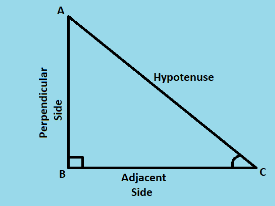Trigonometric Ratios
Trigonometry is a branch of mathematics that deals with the relationship between the angles and sides of a right triangle. This step-by-step guide teaches you trigonometric ratios.

Related Topics
A step-by-step guide to trigonometric ratios
Trigonometric ratios are the ratio of the lengths of the sides of a triangle. These ratios in trigonometry relate the ratio of the sides of a right triangle to the corresponding angle. There are six trigonometric ratios, namely, sine, cosine, tangent, secant, cosecant, and cotangent. These ratios are written as \(sin\), \(cos\), \(tan\), \(sec\), \(cosec\) (or \(csc\)), and \(cot\) in short.
The values of these trigonometric ratios can be calculated using the measurement of an acute angle, \(θ\), in a right triangle.

What are trigonometric ratios?
These six trigonometric ratios can be defined as:
Sine: In the given triangle, the \(sin\) of the angle \(θ\) can be considered as follows, \(\color{blue}{sin\: θ = \frac{AB}{AC}}\).
Cosine: In the given triangle, the \(cos\) of the angle \(θ\) can be considered as follows, \(\color{blue}{cos\: θ = \frac{BC}{AC}}\).
Tangent: In the given triangle, the \(tan\) of the angle \(θ\) can be considered as follows, \(\color{blue}{tan\: θ = \frac{AB}{BC}}\).
Cosecant: In the given triangle, the \(cosec\) of the angle \(θ\) can be considered as follows, \(\color{blue}{cosec\: θ = \frac{AC}{AB}}\).
Secant: In the given triangle, the \(sec\) of the angle \(θ\) can be considered as follows, \(\color{blue}{sec\: θ = \frac{AC}{BC}}\).
Cotangent: In the given triangle, the \(cot\) of the angle \(θ\) can be considered as follows, \(\color{blue}{cot\: θ = \frac{BC}{AB}}\).
Trigonometric ratios formulas
We can use the shorthand form of trigonometric ratios to compare the length of both sides with the base angle. The angle \(θ\) is acute \((θ<90º)\) and in general is measured with reference to the positive \(x\)-axis, in the anticlockwise direction. The basic trigonometric ratio formulas are given below,
- \(\color{blue}{sin\: θ = \frac{Perpendicular}{Hypotenuse}}\)
- \(\color{blue}{cos\: θ = \frac{Base}{Hypotenuse}}\)
- \(\color{blue}{tan\: θ = \frac{Perpendicular}{Base}}\)
- \(\color{blue}{sec\: θ =\frac{Hypotenuse}{Base}}\)
- \(\color{blue}{cosec\: θ = \frac{Hypotenuse}{Perpendicular}}\)
- \(\color{blue}{cot\: θ = \frac{Base}{Perpendicular}}\)
Trigonometric Ratios – Example 1:
Find the value of \(tan\:θ\) if \(sin\:θ\:=\frac{10}{3}\) and \(cos\:θ\:=\frac{5}{3}\:\).
Solution: Use the formula of the trigonometric ratio to solve this problem: \(tan\: θ = \frac{Perpendicular}{Base}\).
\(tan\:θ =\frac {10}{5}=2\)
Related to This Article
More math articles
- Top 10 Tips to Overcome AFOQT Math Anxiety
- How to Multiply Exponents? (+FREE Worksheet!)
- Complete the Equation: How to Finish Subtraction and Addition Sentences with Mixed Numbers
- The Ultimate ACT Math Formula Cheat Sheet
- 5 Best Laptops for Math Teachers
- How is the ATI TEAS 7 Test Scored?
- A Comprehensive Collection of FREE PSAT Math Practice Tests
- Logistic Models And Their Use: Complete Explanation, Examples And More
- 4th Grade PARCC Math Worksheets: FREE & Printable
- Students Make the Most Mistakes in These Math Topics





















What people say about "Trigonometric Ratios - Effortless Math: We Help Students Learn to LOVE Mathematics"?
No one replied yet.